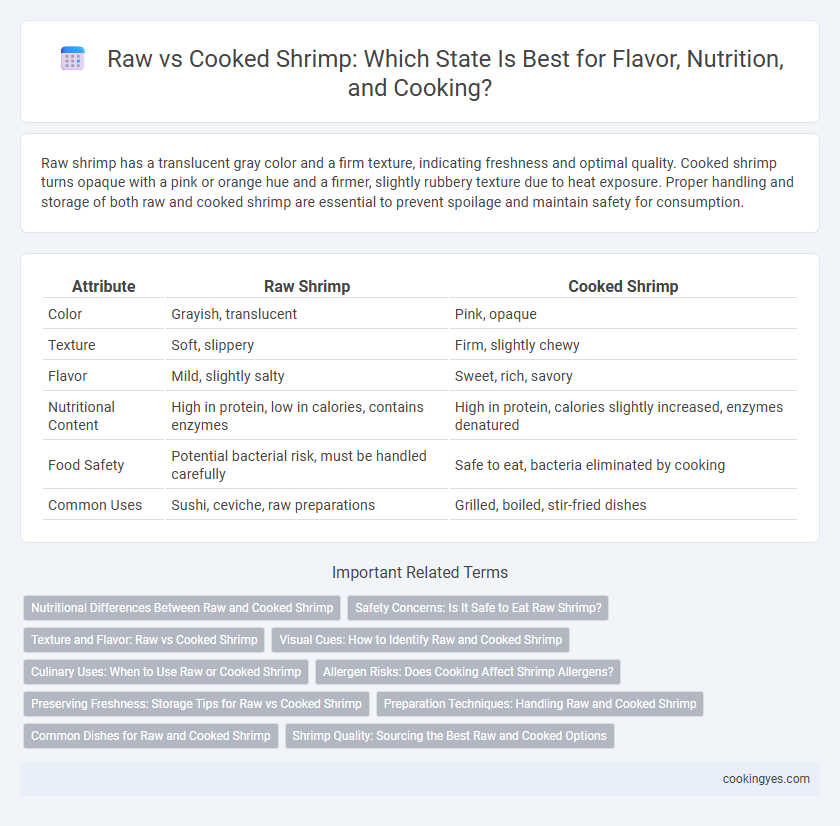Raw shrimp has a translucent gray color and a firm texture, indicating freshness and optimal quality. Cooked shrimp turns opaque with a pink or orange hue and a firmer, slightly rubbery texture due to heat exposure. Proper handling and storage of both raw and cooked shrimp are essential to prevent spoilage and maintain safety for consumption.
Table of Comparison
| Attribute | Raw Shrimp | Cooked Shrimp |
|---|---|---|
| Color | Grayish, translucent | Pink, opaque |
| Texture | Soft, slippery | Firm, slightly chewy |
| Flavor | Mild, slightly salty | Sweet, rich, savory |
| Nutritional Content | High in protein, low in calories, contains enzymes | High in protein, calories slightly increased, enzymes denatured |
| Food Safety | Potential bacterial risk, must be handled carefully | Safe to eat, bacteria eliminated by cooking |
| Common Uses | Sushi, ceviche, raw preparations | Grilled, boiled, stir-fried dishes |
Nutritional Differences Between Raw and Cooked Shrimp
Raw shrimp retain higher levels of certain water-soluble vitamins such as B vitamins, while cooking can cause some nutrient loss due to heat exposure. Cooked shrimp typically have increased protein digestibility and reduced harmful bacteria, improving food safety and nutrient absorption. Mineral content like zinc and selenium remains relatively stable regardless of cooking, offering essential health benefits in both forms.
Safety Concerns: Is It Safe to Eat Raw Shrimp?
Raw shrimp can harbor harmful bacteria and parasites such as Vibrio and Salmonella, posing significant health risks if consumed without proper handling. Cooking shrimp to an internal temperature of 145degF (63degC) effectively eliminates these pathogens, ensuring safety. Eating raw shrimp is generally unsafe unless sourced from reputable suppliers specializing in sushi-grade or previously frozen shrimp to reduce microbial contamination.
Texture and Flavor: Raw vs Cooked Shrimp
Raw shrimp have a translucent, firm texture with a mild, slightly sweet flavor that complements sushi and ceviche dishes. Cooked shrimp turn opaque with a firmer, springier bite, enhancing their natural sweetness and imparting a savory, briny taste. The textural contrast between raw and cooked shrimp significantly influences culinary applications and flavor profiles in seafood cuisine.
Visual Cues: How to Identify Raw and Cooked Shrimp
Raw shrimp are translucent with a grayish-blue tint and a soft, flexible texture, while cooked shrimp turn opaque and display a bright pink or reddish color with firm, springy flesh. The shell of raw shrimp is usually glossy and semi-transparent, contrasting with the matte appearance of the cooked shell. Noticing these visual cues such as color change and shell texture helps in quickly distinguishing raw shrimp from cooked shrimp accurately.
Culinary Uses: When to Use Raw or Cooked Shrimp
Raw shrimp is ideal for dishes like ceviche and sushi, where its delicate texture and natural sweetness shine through after minimal preparation. Cooked shrimp is preferred in recipes requiring firm texture and enhanced flavor, such as shrimp cocktails, stir-fries, and pasta. Choosing between raw and cooked shrimp depends on desired culinary application, ensuring optimal taste and texture.
Allergen Risks: Does Cooking Affect Shrimp Allergens?
Cooking shrimp does not eliminate allergenic proteins such as tropomyosin, which remain potent triggers for shrimp allergies. Both raw and cooked shrimp pose significant allergen risks, with heat sometimes altering protein structures without reducing allergenicity. Individuals with shellfish allergies should avoid shrimp in any form to prevent allergic reactions.
Preserving Freshness: Storage Tips for Raw vs Cooked Shrimp
Raw shrimp should be stored at 32degF (0degC) in an airtight container or tightly sealed plastic bag to maintain optimal freshness and prevent bacterial growth. Cooked shrimp, chilled promptly and kept in a shallow covered container, remain safe to consume for up to 3-4 days when refrigerated at or below 40degF (4degC). Freezing raw shrimp at 0degF (-18degC) extends shelf life for up to six months, while cooked shrimp should be frozen only if fresh, to preserve texture and flavor upon thawing.
Preparation Techniques: Handling Raw and Cooked Shrimp
Proper handling of raw shrimp involves thorough rinsing under cold water and deveining to remove the digestive tract, ensuring safety and freshness. Cooking methods like boiling, grilling, or sauteing transform shrimp's texture and flavor while requiring precise timing to prevent toughness. Post-cooking, shrimp must be promptly chilled to inhibit bacterial growth and maintain optimal taste and quality.
Common Dishes for Raw and Cooked Shrimp
Raw shrimp is commonly used in dishes such as shrimp ceviche, sushi, and shrimp tartare, where its delicate texture and subtle sweetness are highlighted through minimal preparation and marination. Cooked shrimp appears in a wide range of popular recipes including shrimp scampi, shrimp cocktail, gumbo, and shrimp stir-fry, offering a firm texture and enhanced flavor profile due to boiling, grilling, or sauteing. The choice between raw and cooked shrimp significantly influences the culinary application, with raw shrimp favored in cold, fresh presentations and cooked shrimp preferred in warm, hearty meals.
Shrimp Quality: Sourcing the Best Raw and Cooked Options
Shrimp quality depends significantly on sourcing practices, with the best raw shrimp often harvested from sustainable, cold-water environments that preserve freshness and texture. Cooked shrimp quality hinges on gentle processing methods that maintain the shrimp's natural flavor and firmness while preventing overcooking and spoilage. Selecting shrimp from reputable suppliers who prioritize traceability and freshness ensures optimal taste and nutritional value in both raw and cooked forms.
Raw vs Cooked for shrimp state Infographic

 cookingyes.com
cookingyes.com